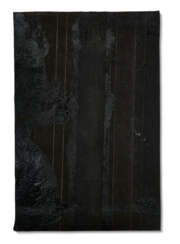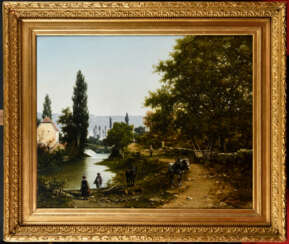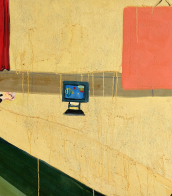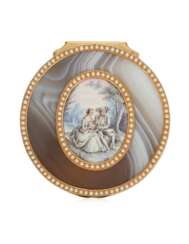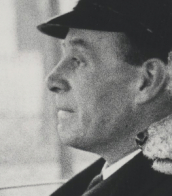gate

Theaster Gates is an American social practice installation artist and a professor in the Department of Visual Arts at the University of Chicago.
Gates' work has been shown at major museums and galleries internationally and deals with urban planning, religious space, and craft. He works to revitalize underserved neighborhoods by combining urban planning and art practices. Gates' art practice responds to disinvestment in African-American urban communities, particularly in the wake of the financial crisis of 2007-2008, addresses the importance of formal archives for remembering and valuing Black cultural forms, and disrupts artistic canons, especially those of post-painterly abstraction and color field painting.


Theaster Gates is an American social practice installation artist and a professor in the Department of Visual Arts at the University of Chicago.
Gates' work has been shown at major museums and galleries internationally and deals with urban planning, religious space, and craft. He works to revitalize underserved neighborhoods by combining urban planning and art practices. Gates' art practice responds to disinvestment in African-American urban communities, particularly in the wake of the financial crisis of 2007-2008, addresses the importance of formal archives for remembering and valuing Black cultural forms, and disrupts artistic canons, especially those of post-painterly abstraction and color field painting.


Theaster Gates is an American social practice installation artist and a professor in the Department of Visual Arts at the University of Chicago.
Gates' work has been shown at major museums and galleries internationally and deals with urban planning, religious space, and craft. He works to revitalize underserved neighborhoods by combining urban planning and art practices. Gates' art practice responds to disinvestment in African-American urban communities, particularly in the wake of the financial crisis of 2007-2008, addresses the importance of formal archives for remembering and valuing Black cultural forms, and disrupts artistic canons, especially those of post-painterly abstraction and color field painting.


Theaster Gates is an American social practice installation artist and a professor in the Department of Visual Arts at the University of Chicago.
Gates' work has been shown at major museums and galleries internationally and deals with urban planning, religious space, and craft. He works to revitalize underserved neighborhoods by combining urban planning and art practices. Gates' art practice responds to disinvestment in African-American urban communities, particularly in the wake of the financial crisis of 2007-2008, addresses the importance of formal archives for remembering and valuing Black cultural forms, and disrupts artistic canons, especially those of post-painterly abstraction and color field painting.


Theaster Gates is an American social practice installation artist and a professor in the Department of Visual Arts at the University of Chicago.
Gates' work has been shown at major museums and galleries internationally and deals with urban planning, religious space, and craft. He works to revitalize underserved neighborhoods by combining urban planning and art practices. Gates' art practice responds to disinvestment in African-American urban communities, particularly in the wake of the financial crisis of 2007-2008, addresses the importance of formal archives for remembering and valuing Black cultural forms, and disrupts artistic canons, especially those of post-painterly abstraction and color field painting.
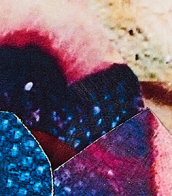

Theaster Gates is an American social practice installation artist and a professor in the Department of Visual Arts at the University of Chicago.
Gates' work has been shown at major museums and galleries internationally and deals with urban planning, religious space, and craft. He works to revitalize underserved neighborhoods by combining urban planning and art practices. Gates' art practice responds to disinvestment in African-American urban communities, particularly in the wake of the financial crisis of 2007-2008, addresses the importance of formal archives for remembering and valuing Black cultural forms, and disrupts artistic canons, especially those of post-painterly abstraction and color field painting.


Theaster Gates is an American social practice installation artist and a professor in the Department of Visual Arts at the University of Chicago.
Gates' work has been shown at major museums and galleries internationally and deals with urban planning, religious space, and craft. He works to revitalize underserved neighborhoods by combining urban planning and art practices. Gates' art practice responds to disinvestment in African-American urban communities, particularly in the wake of the financial crisis of 2007-2008, addresses the importance of formal archives for remembering and valuing Black cultural forms, and disrupts artistic canons, especially those of post-painterly abstraction and color field painting.


Karl Gatermann the Elder was a German painter and graphic artist. He was the uncle of artist Karl Gatermann, who is typically called "Karl Gatermann the Younger" to distinguish between the two. In 1910 he received the First Prize for Painting of the City of Munich for the oil painting Life. From 1919 to 1942 he lived and worked in Lübeck. In Berlin in 1923 and 1925, he exhibited his watercolors in the galleries of Rudolf Wiltschek and in the Kunsthaus Heumann in Hamburg in 1926. Gatermann's watercolors were also shown in England and in the London Times. Gatermann predominantly focused on north German landscapes and cities, though he also painted still life and figurative scenes, and portraits of people.


